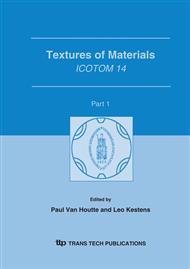p.1395
p.1401
p.1407
p.1413
p.1419
p.1425
p.1431
p.1437
p.1443
The Role of Special Boundaries during Solidification and Microstructure Evolution in Lead Free Solder Joints
Abstract:
Solder joints based on Sn-Ag used in electronic systems fail due to thermomechanical fatigue (TMF) damage that develops during service. Grain boundary sliding and/or shear band formation are observed during TMF. Orientation Imaging Microscopy (OIM) was used to study the damage that develops and relate it to slip systems and the grain boundary character that is prevalent in tin. A number of special boundaries form preferentially during solidification, and those with misorientations about a [110] axis, including low angle boundaries, are more likely to slide with thermal cycling. Special boundaries aligned to have large resolved shear stress exhibit large scale sliding, and others with normal stress components exhibit fracture. Damage accumulation depends on the deformation mode, temperature, and initial crystal orientations present in the joint.
Info:
Periodical:
Pages:
1419-1424
Citation:
Online since:
September 2005
Authors:
Price:
Сopyright:
© 2005 Trans Tech Publications Ltd. All Rights Reserved
Share:
Citation:


